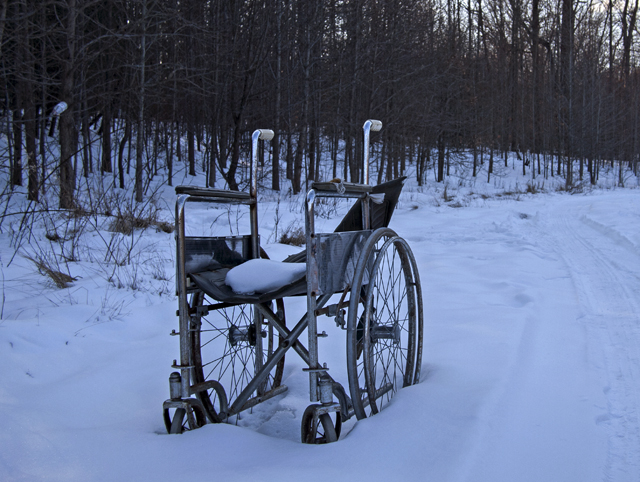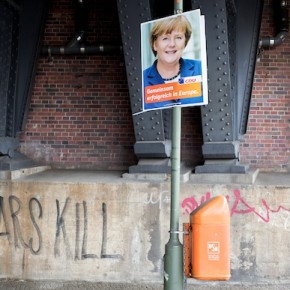When most people visit the Washington D.C. area, they think of visiting the Smithsonian, or perhaps the White House or Pentagon. But when I met up with a friend on a recent trip there, we had our hearts set on an abandoned mental asylum.
We both love exploring ruins, especially ones with a complex history. And institutional settings hold a special appeal. That’s why Forest Haven — largely intact and relatively easy to access in nearby Laurel, Maryland — was a perfect tourist destination. What better place for two outsider artists to explore than the empty halls of buildings that once were used to warehouse society’s rejects?
Situated in the woods outside of Laurel, hidden from the steady stream of traffic rushing down nearby Highway 198, Forest Haven Asylum occupies over 250 acres and is comprised of over 30 buildings. Opened in 1925 as a place to house “the mentally retarded,” who at that time were often institutionalized, it provides a window onto a world society would mostly rather ignore or forget.
The idyllic setting in the woods and the elaborate brick architecture were supposed to provide a soothing and healing environment, But the legal record and the oral and written history of Forest Haven, which closed in 1991 after a series of budget cuts and lawsuits, reveal that it was more like Hell for the thousands of people who were left to deteriorate and often die within its walls. Forest Haven’s real purpose wasn’t to provide comfort for its residents, but for the rest of society, sequestering its unwanted out of sight, even as the wheels of the U.S. government churned just up the road.
Forest Haven is so vast and so overwhelming with evidence of a horrifying mental (un)health culture that we ended up returning to its grounds several times during my stay in the Washington D.C. area. One day was not enough, just as one chapter of our story will not be enough. It takes time to dissect the experience. This is the first chapter.
The more time my friend and I spent at Forest Haven, the more we learned of the institution’s history. We became both obsessed with and possessed by the place. As we explored the buildings with our cameras, we viscerally experienced the abominable lives of its former residences through the evidence they left behind, a sea of abandoned material that stands in for the institution and the dehumanization of its human charges. In the end, I shot over 400 photographs and left the East Coast haunted by my experiences at Forest Haven. It has been months since I returned to my home in Arizona, but I continue to dream of those dark halls.
Although Forest Haven originally was a home for mentally retarded children, it eventually went on to house a wide variety of patients from the fringes of society, including the mentally ill, the addicted, the dyslexic, non-native speakers, orphans and just plain outsiders, perhaps even some artists who didn’t fit the mold of “normal”: thousands whose only crime was making other people uncomfortable. Many of the children who were dumped at Forest Haven spent their entire lives there. There are records of residents spending over fifty years behind those walls until they finally were freed or died.
The asylum was constructed as part of the early-twentieth-century philosophy that building mental asylums in pastoral rural areas would be good for mental health. Its original old brick buildings follow the architectural traditions of its era. The designers figured beautiful buildings would allow for peaceful minds. However, blueprints and a bunch of bricks and mortar don’t account for the quality of life of the actual real living (and dying) people who would occupy asylums.
When it first opened, Forest Haven did appear to adhere to its idyllic philosophy. Kids worked on a farm and learned how to grow vegetables, milk cows and perform other practical labor. But by the mid-1960s, government budget cuts had turned the facility into a filing cabinet for human beings. Qualified staff, social workers, and psychiatrists were replaced by glorified babysitters and guards. At one point there were only two social workers for nearly 3,000 residents. The very grounds which had once been devoted to gardens became dumping grounds for hundreds of dead bodies buried in unmarked graves.
When Forest Haven closed its doors in 1991, it left a long history of being an overcrowded, understaffed, underfunded government institution that abused and overmedicated its residents and routinely performed such barbaric “treatments” as lobotomies, electroshock and hydro-therapy. Hundreds of innocent wards of the state died from aspiration pneumonia as they were tied to their beds, force fed, and then inhaled their food. It is truly the kind of place about which horror films have been made.
The first day we headed out to Laurel, a late February afternoon, I was still on Arizona time, so we were running two hours behind schedule and chasing the clock. The sun was already low in the sky, but we were determined to find the place and capture the remains of the day on its grounds. We arrived close to 3 pm and found our way to the road that leads to the asylum. Unfortunately the road was blocked by a guard shack, barriers, and a bad-ass uniformed guard who greeted us a big smile and one hand on the butt of his gun. Knowing we had to play it cool, we decided that being matter-of-fact was best. So we told him we were looking for the abandoned asylum as if it was the most normal thing in the world.
“That old place?” he asked. “I don’t know why so many people want to go up in there.” He then told us there was no way he could let us through. He explained that he worked for the new Youth Detention Center that had been built right down the road, “where they put all the bad kids from The District.” Ah, yes, a warehouse for “criminal” youth. Some things never change . . . The new juvenile facility was at the bottom of the hill. It loomed over the treetops, an eerily sterile cement block building circled with razor sharp wire, guard shacks, security towers, and flood lights. Its blank walls look over the grounds of the abandoned Forest Haven. I wonder what the kids in the new facility think of all the kids who lived and died in Forest Haven or if they even know what all those old buildings are.
The guard then used scare tactics to deter us from trying to explore the asylum. He told us that the NSA uses the grounds for training. He said that if we went down there, we were likely to be confronted with sniffing dogs and NSA operatives all too willing to perform full cavity searches. He said, “I could tell you the stories of people who have run into NSA down there. You don’t want to know . . .” We could picture it all too well. No need to go into the details.
He then told us that they track cell phones on the land (which is owned by the government) and that they use cell phone signals to hunt people down with the aforementioned sniffing dogs and latex glove wearing NSA operatives. He strongly discouraged us from going further. Then as an aside he said, “But then again some people do go through the woods, if they are willing to risk it.” We told the guard that we definitely were not willing to risk a confrontation with NSA or its dogs and cavity searchers. We assured him there was “no fucking way” we would do that, flipped a U-Turn and high-tailed it out of there.
We figured we should kill at least an hour before we should attempt to reach Forest Haven through the woods. On our way back to town, we actually spotted an old building off one side of the road and what looked like a trail in the snow heading into the woods from a restaurant parking lot. We spent an hour driving around Laurel passing time and watching the clock, the sun sinking lower every minute.
It was after four o’clock by the time we turned off our cell phones to avoid being tracked by the NSA. We stepped onto the icy trail, hoping it would lead us to Forest Haven, though we couldn’t see the asylum from the road. The guard had told us that it was “down there,” pointing down the hill off into the distance behind hundreds of trees. We stomped down the icy trail through the stark forest, slipping and crunching along. Along the way, we passed a burnt-out brick building and a severed tree stump with a bed sheet draped over it. Finally the trail opened up and there it was: Forest Haven.
We were greeted by a single wheelchair sitting in the snow in front of a dark block building that looked like something out of communist Eastern Europe. Behind the massive cement building, the spires of the original administration building stabbed upward at the darkening sky. Aware that our time was very limited, we decided to explore the original central building.
Light was fading fast. We ran quickly across the snow, trying to stay in the shadows and dodge those NSA who might sprint out to catch us any moment. The doors to the main building gaped wide open, as if they were inviting us to enter. We walked inside and were hit with the reality of the place immediately. This was no longer just a “myth” we read about on the internet or something from a psychology history book. The entire building pressed in on us and echoed with thousands of ghosts and stories that reverberated through its walls.
This is where the children had been dumped. This is where they had processed people like so much disposable paper. We were in the heart of The Institution. The building might have closed in 1991, but it was still very much alive. When the staff and handful of remaining residents had departed, they simply left everything behind. Patient files. Desks. Chairs. Medical equipment. Vending machines. Much of it remained exactly where it was, except that decay had taken over. Collapsing ceilings, dislodged floor tiles, and piles of asbestos were reminders of how toxic and dangerous this place was.
The enormity of the place and its potential hidden dangers slammed us. We immediately set ground rules for each other’s safety. Stay on the same floor. Be very quiet. Never be so far away that we can’t hear each other. Then, we moved forward as stealthily as possible and began shooting photos with what remained of the rapidly fading light.
This building clearly was the Capital of Abandoned chairs. Every room contained chairs as if the people who sat in them — patients or staff — had left just seconds before we arrived. Chairs stood in corners facing walls; leaned akimbo in dark doorways; faced windows looking onto the barren winter landscape and the empty buildings that occupied it. One row of rooms housed dental chairs which could have been used for dental work or lobotomies, according to the records we later discovered.
This relic — the Administration Building — is the place where they processed the abandoned and forgotten. Lone chairs sat at desks, ready for the intake of new residents. I thought of all the children who had come through these doors with a single suitcase in their hands. Their voices whispered through holes in the roof, portals for lost souls.
A green arrow pointed down a stairway to the basement. We began do descend the stairs, but it was pitch black down there. We set another rule for the day. No basements. As I moved through the rooms shooting photos, I sometimes literally felt the air around me stir as if bodies were passing me. But I tried to find the “off switch” in my psyche and keep moving and shooting, even though the place felt like it was suffocating me.
We climbed the stairs to the second floor. The scene was literally frozen in time. Icicles dripped from the rafters. The floors were covered with sheets of ice. We stepped carefully so we wouldn’t crash onto or through the floor. An old Pepsi machine sat adrift in snow. A sink dripped ice from its faucet. Frozen pipes. Frozen lives. Frozen deaths. Frozen time.
We finally left the main building and darted across the snow to one of the original dormitories, which were referred to as “cottages,” as if that cozy name couls take the sting off of what this place really was. We worked our way through one of the cottages, but we were losing light fast. Dark was setting in, and the sky was the color of a bad bruise.
A lone stroller sat in one room reminding us that very tiny children were left here. In the corner, a black metal bed frame was shoved against a charred wall. This was the first bed we found, the first evidence that people spent their nights in this place. Couches were piled in the recreation room where residents gathered to stare out the windows or at the television, once that became an option.
Outside basketball hoops stood like sentinels. Ravens gathered at the top of barren poles waiting for night to fall. And it was falling. Fast. We had to get out of there. We looked at the sprawl of buildings surrounding us and realized we had only scratched the surface. But neither one of us had any interest in being on those grounds at night. We crunched our way toward the icy trail with frozen hands and shaking legs. The wheel chair marked the entrance to the woods. The large block building was now entirely black in shadow.
After we had made it back to the car, unmolested by NSA operatives, I turned to my friend. “Let’s come back tomorrow,” I said. Yes, I love to see the art in the Smithsonian’s museums. But this first experience of Forest Haven had been too intense to follow up with such typical tourist fare. I couldn’t help myself. I needed to see more, learn more, find more, even if being there felt like a kind of grave robbing, as we dug up more evidence of how gruesomely our society disposes of the unwanted.
That night, my friend and I both dreamed of the asylum. It infiltrated every inch of our psyches. Yet, we had only just begun. We still had two more days that we would spend there, and so much more to discover. . .
All photographs courtesy of the author. Look for the rest of this story in future Souciant pieces. To see more photos, visit the gallery on the author’s website.

















